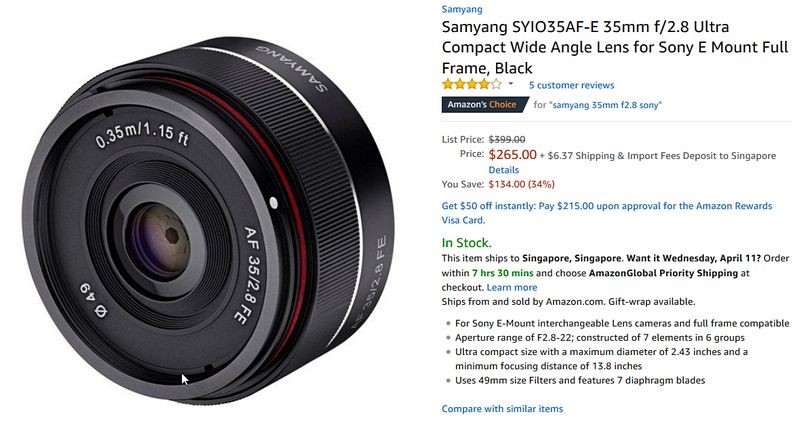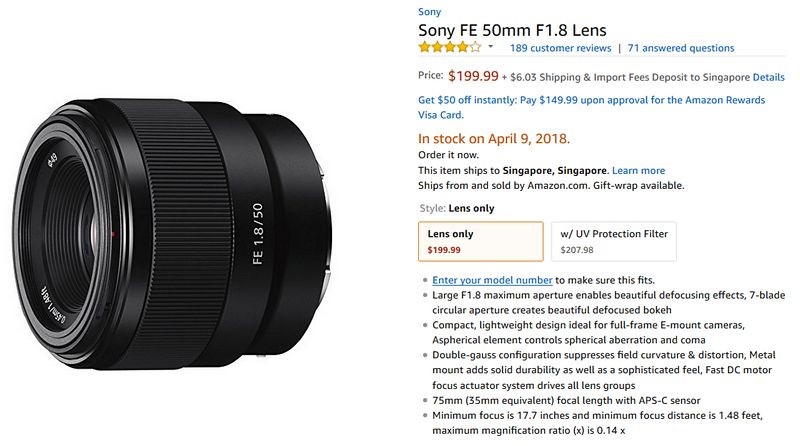Continuing in my series of posts on moving from m4/3 to the Sony Alpha FE as my principal system for photography.
What lens to acquire first? The m4/3 standard is a pretty mature system, with a huge range of high quality prime and zoom lenses. Many of them modestly priced too. The Sony FE mount is catching-up, aided also by the number of both OEM and third party lens adapters that make it possible to use lenses from its previous generation Sony A mount and also from other manufacturers. But much of its equivalent lens catalog is also at higher price-points, and invariably all heavier and bulkier. As expected given that the lens glass elements need to cover a full-frame sensor that’s so much larger than a m4/3 sensor.
An analysis of the pictures I’ve taken now over the last 10 years note which are the lenses I used most often for each of the two families: DX and m4/3. The table below also lists each lens’ 35mm film focal length equivalent in parenthesis, and also a collective thought on each. Full-frame lenses are marked with an * too.
| Camera System | Lenses | Remarks |
| Nikon DX (2008 – 2012) Cameras I had were:Nikon D300 (2008 – 2012)Nikon D7000 (2012 – 2014) |
Sigma 18-250mm (27-375mm eqv) | The all-in-one travel lens, and very heavily used over a period of 3 years when I traveled a lot over 2009 to 2011. The larger the imaging sensor, the more complex any such all-in-one lens design would be too and compromises needed to achieve a reasonable size and price-point. |
| Sigma 24-60mm f2.8* (36-90mm eqv) | The lens was being phased out at the point of purchase, so I bought it at a bargain bin clearance price off Amazon. It was tack-sharp in the centre, and a lot of photos of Hannah as a baby were taken on it. | |
| Nikon 18-55mm (27-82.5mm eqv) | Kit lens that came with the D300 10 years ago. Took quite a few pictures on it before it was succeeded and bettered by the Sigma 24-60mm f2.8 in every respect. | |
| Nikon 35mm f1.8 (52.5mm eqv) | Another really desirable prime for its price-point, and Nikon very successful attempt to create a ‘normal’ 50mm focal length prime for the DX system. | |
| Nikon 50mm f1.8* (75mm eqv) | The ‘standard’ prime lens that’s a common inclusion for many enthusiasts. | |
| Sigma 70-200mm f2.8* (105-300mm eqv) | Fairly pricey f2.8 telephoto zoom lens, but still cheaper than Nikon’s equivalent. Didn’t get much use of it before I sold it away after moving to m4/3 shortly thereafter. | |
| Sigma 10-20mm (15-30mm eqv) | The first ultra wide-angle I had. The sum of my limited use of it is that UWAs are not for me, and the widest I’d care to normally shoot at would be about 24mm equivalent. | |
| Sigma 120mm f2.8* Macro (180mm eqv) | Still the only dedicated macro lens I’ve owned, like ever! | |
| Micro Four Thirds (2010 to present)
*Didn’t include any of the 12-35mm kit lenses
Cameras I have are: E-PL1 (2010 – 2012) E-PL2 (2011+) E-M5 (2012+) E-PL6 (2013+) E-M1 (2015+) GX85 (2017+) |
Olympus 17mm f1.8 (34mm eqv) | This lens is practically married to my E-PL6, and the combination I most frequently take out when we’re out of home. All those cheeky shots over the last 5 years of Hannah/Peter across the dining table, in NTUC Fairprice trolley carts – all using this amazing prime lens. |
| Olympus 45mm f1.8 (90mm eqv) | My Go To lens for portraiture. The 90mm equivalent focal length though makes it a little harder to use when using indoor. But when I do have the space to work with it, the subject isolation and bokeh achieved in the pictures are just great. | |
| Olympus 12-40mm f2.8 (24-80mm eqv) | For convenience and sheer versatility when travelling, a 24-70mm equivalent f2.8 lens is hard to beat. The Sony FE equivalent of this lens is dreadfully expensive though and also bulky – so I’ll probably have to give up this lens type when I transit to the Sony Alpha FE system. | |
| Panasonic-Leica 25mm f1.4 (50mm eqv) | Another perennial favorite among m4/3 users, and the third in the ‘trinity’ of lenses that are found in most enthusiast bags. | |
| Olympus 40-150mm f2.8 (80-300mm eqv) | I didn’t think I’d get so much use out of this f2.8 telephoto zoom, but the Club Med Bintan, Melbourne and Western Australia trips proved me so wrong. And outside vacations, this lens is also used for our guinea pig/hamster pictures at home. And when the full moon comes up, the lens with the 1.4 teleconverter come out to play too. But as pricey as the Olympus 40-150mm f2.8 was, the Sony FE f2.8 equivalent cost is eye-watering. I’ll have to rob a bank to afford that! So I might just go with the cheaper f4 version when the time comes. | |
| Panasonic 20mm f1.7 (40mm eqv) | At 40mm equivalent, I found this lens neither here nor there to work with. Like the 14mm f2.5 below, this lens is very compact and pancake-like. But unlike the relatively brisk 14mm f2.5 AF-speed wise, the 20mm f1.7 focused so slowly that I ended up selling it away. There are some fun shots of Hannah as a three year old from it though. | |
| Panasonic 14mm f2.5 (28mm eqv) | This is also another fun lens to use for landscape and group shots, what with its somewhat wide focal length. Not quite so appropriate for head shots in portrait mode though. I had it for a while, and sold it away when I got the E-M5/12-50mm. If there was ever a lens I regretted selling, it’d be this. This lens would had been perfect for wefies! | |
| Olympus 12-50mm (24-100mm eqv) | The kit lens that came bundled with the E-M5 from 6 years ago (wow – it’s been that long?!). The lens is fairly slow aperture-wise, but has a few tricks to make-up: it supports macro, and is convenient on the long-end at 100mm to do some basic telephoto work too. | |
| Olympus 70-300mm (140-600mm eqv) | The longest zoom I’ve ever shot with, and a lot of those Minton in-development close-ups were done using at monstrous focal lengths. Sold away after I picked up the 40-150mm f2.8. | |
| Sigma 30mm f2.8 (60mm eqv) | Super sharp in the centre, but I sold it away after I got the far superior Panasonic 25mm f1.4. |
Going with this table above and also taking a large cue from the system I’m still using a lot, the Sony FE mount lens types I should be seriously considering would be:
- 35mm f2.8
- 50mm f1.8
- 85mm f1.8
- 24-70mm+ f4
- 70-200mm+ f4
There are reasonably/affordably priced – whew – versions of the first two lens types. I decided to go with third party options for the first: the Samyang 35mm f2.8 whose Amazon price is significantly lower than as sold in stores here, and also costs about a third of the Sony Zeiss equivalent; and the Sony FE 50mm f1.8, which I picked up at a slightly lower than standard retail as a price with purchase with the A73. Both lenses should be available for my day 1 exploration of the A73 in a fortnight. There are of course better versions of both lenses for the Sony FE mount – especially for the 50mm-wise type, as the ‘Nifty Fifty’ FE 50mm f1.8 I’m getting is widely regarded as sharp but also tortoise-powered when it comes to AF. But the better versions are also several times more expensive. So, no thanks at this point.


The next three lenses on the list are going to be increasingly harder decisions. The Sony FE 85mm f1.8 is but one of four lenses on this focal length for the Sony FE mount, everyone of them highly regarded. Despite it being the cheapest of the bunch, it can stand its own against the other three. So still a relatively easy decision – that’ll be the one I’ll buy at some point for portraiture in the 85-90mm.
Deciding on the last two lenses will be really tough, more so that I’m seriously thinking of having the Sony A73 do principal duty in our upcoming Bali trip – i.e. I’ll need a 24-70mm+ lens soon to use. As good as the Olympus 12-40mm (24-80mm eqv) f2.8 is, I’ve also found myself wishing for the lens to be a little longer on the telephoto end and reaching what the old Olympus 12-50mm (24-100mm eqv) could do. As it turns out, there’s one such Sony FE lens: the 24-105mm f4. There’s no way though that I can afford the 24-105mm f4 and a 70-20mm+ f4 this year – it’s one or the other only. So, the E-M1 + 40-150mm f2.8 might still be coming along for the trip alongside the A73 – just for all those long shots of birds, animals, and of the two kids going nuts on the padi fields (maybe!) and the Treetop Adventure Park.
And finally, addressing my elephant in the room: I was initially thinking of fully moving to the Sony FE system and selling away all my m4/3 gear – if nothing else to fund the transition to A73. But I’ve enjoyed the m4/3 system so much, and treasure its small form factor and overall versatility that I’m loathed to give it all up. So, at least for this year, I’ll still be holding onto the my favorite bits of it: likely the E-M1/E-PL6 bodies and the 40-150mm f2.8, 17mm f1.8 and 45mm f1.8 lenses first at least, and sell away the rest.
Next post on my very first and early impressions of the A7 Mark III after it arrived.
The series of Sony A7 III posts:
Sony A7 III – Part 1 – Journey to Alpha-verse
Sony A7 III – Part 2 – Lens Sense Making
Sony A7 III – Part 3 – Early Impressions
Recent comments